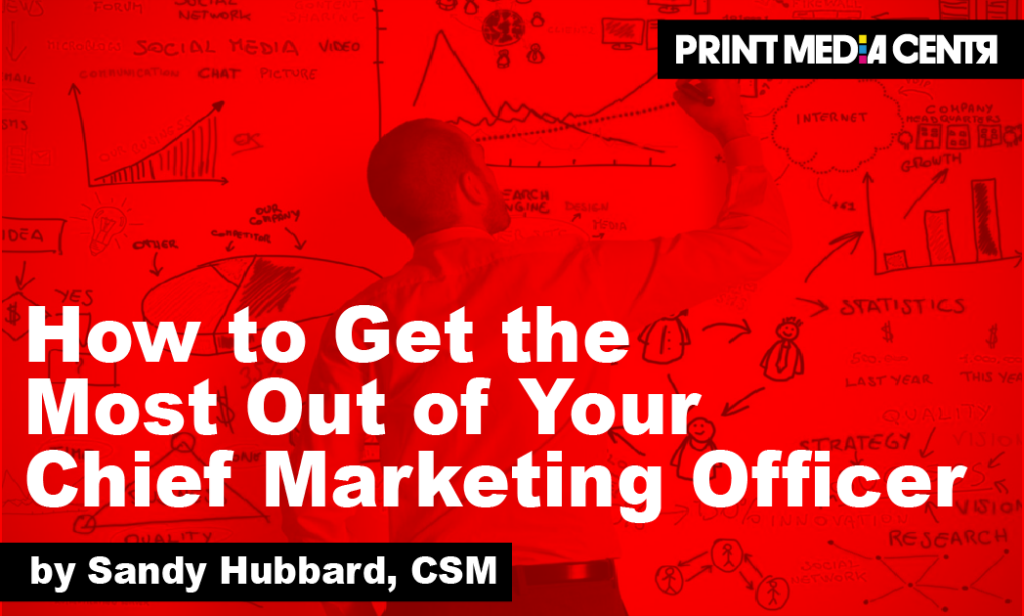
Printing company owners think I’m kidding when I say that a Chief Marketing Officer can do even more than they’re doing now. Many CMOs in the printing industry are not working to their potential or ability. And most are not being utilized in the C-suite the way they could be. The reason for this starts with the mindset and attitude at the very top of the printing company.
From my vantage point as a marketing advisor, I see a big problem in how the marketing department is viewed by owners and leadership in most printing companies.
MARKETING IS OFTEN VIEWED AS ADJUNCT
Often the marketing department is viewed as an add-on to the sales department. It’s seen as optional, sometimes problematic, unpredictable, and rarely taken seriously.
And then what happens?
Marketing initiatives in companies that view marketing as a nuisance will find their employee turnover higher in the marketing department, especially the manager or CMO. Teams get fed up when projects are green-lighted, then amber-lighted, then no-go. Loyalty wanes when a marketing department can’t achieve its potential. It’s demoralizing when campaigns are put on hold to “save money,” and then the resources are siphoned to other pet projects.
What’s needed is a systematic, committed approach to marketing.
Fixing these problems begins with company leaders. In the printing industry (and manufacturing sectors in general), owners tend to see CMOs as worker bees instead of the kind of leaders who can bring strong strategic value to the organization.
MARKETING STARTS AT THE TOP
If you’re a printing company CEO, owner, president, stakeholder, partner, investor, or other member of the leadership team, here are three things to do to get the most out of your chief marketing officer.
- Empower the CMO.
- Fund the department, not just projects.
- Strengthen the C-suite’s value to the organization and improve how it integrates with leadership and the board.
We make these changes not for the happiness of your marketing chief. No – we make these changes so success will flow through your organization. Your CMO’s success inspires your sales and cross-functional teams to play harder and win bigger.
Here’s how to get specific on my recommendations:
- Bring your CMO into the C-Suite.
The title “chief marketing officer” suggests an open door to the C-suite. Yet this is rarely the case in printing companies. Your CMO needs access to all the big-picture goals, decision-making, challenges, and financial information that your other chief officers are seeing. Why is this necessary? Because your CMO is trying to make you more powerful in the marketplace. If there’s a company hiccup, change, or transition on the horizon, your CMO needs to be told the moment your other executive leadership members hear about it. Furthermore, your CMO needs to learn how to be a better contributor, and the best way to do that is to have *real* C-level assignments and responsibilities. If you have an active board of directors or advisors, I recommend you assign the CMO to one of them for mentoring and reporting.
If you haven’t yet hired a CMO and are planning to, check out my post on how to choose the right chief officer for your printing company.
- Give the marketing department an actual budget.
Your CMO needs to be able to weigh projects against one another, prioritize them, choose technology, and hire providers for the tasks you can’t complete in-house. The CMO needs the power and flexibility to adjust for variables and price increases. For example, if your CMO estimated the cost of a project based on last year’s numbers, surprise! Some marketing costs have jumped 30 percent in the last 18 months. Rather than forcing your CMO to come to you, hat in hand, to get projects moving, decide on a realistic number for the annual marketing budget. Give your CMO room to build the best possible projects with what’s allocated. How do you know how much to budget? There are lots of formulas – and I’m happy to share those if you’re interested – but start by asking your CMO. Request an annual budget proposal and have them back it up with industry data and today’s costs.
- Don’t use your CMO as a workhorse.
When I said CMOs like to work hard, I didn’t mean doing the work your teams and contractors should be doing. Yes, we like to get the most for our money from our employees. But for our chief officers, that means strategy, project management, facilitating throughput, and strong analysis. It means holding planning meetings and retrospectives so your teams can learn and improve. I’m in a vigorous Slack group with insanely intelligent marketing pros from around the world. These executives are moving their companies ahead in leaps, not inches. When you hire chief officers of any ilk, high-level thinking is what you’re paying for, so don’t squander it or burn people out by understaffing their department.
- Ask your CMOs for regular reports and accountability.
The monthly report can be a lower-level overview of significant marketing activities, budget summary, wins, and next steps. If you use your board as a mentoring opportunity, the CMO’s monthly report can be sent to the board liaison to be reviewed and presented. Your quarterly report should be a face-to-face presentation by each member of the C-suite to the C-level assembly, if possible. That way, your CMO has time to step up and prepare something that can help the leadership make business decisions. A 90-day update might include: (a) market trends and intel on competitors; (b) an update on mergers and acquisitions in your area; (c) department updates such as new employees; (d) budget requests or changes; and (e) attribution and data on sales, retention, and recapture.
- Train your CMO.
Your CMO is probably doing training on their own dime and time to advance their career – but it may not be the training your company needs. The only way to control that is to have your CMO figure out what type of training would have the most value for the company. Put training in the budget. Have a two-tier reward plan: once training is complete, and when there’s a positive, visible impact on the company. Tying your program to results may sound mean-spirited, but it keeps your CMO motivated to seek the most useful training programs. The goal, after all, is to help your CMOP gain the skills and strategic foundation to help the company be successful.
You can see how each of these recommendations centers around how you and your leadership team view, support, and maximize the talents of your CMO.
These changes will ignite your CMO’s enthusiasm for their job. They will put more effort and creativity into their initiatives. And they’ll transmit their excitement to their teams.
I like win-win situations. Elevating and empowering your CMO is a win-win that benefits the entire company.
MARKETING MINDSET
Getting the most out of your CMO starts with you, the owner.
It may seem overwhelming to give your CMO more power, more insight into the private parts of the company, and more budget than your comfort zone might allow.
Remember, the BEST companies operate this way.
When you adopt the mindset that your CMO is a valuable member of your leadership team, you’ll get the most out of your investment.
Your CMO wants to work hard for you. Let them!
Check out last month’s post:: https://printmediacentr.com/how-to-run-a-diy-print-sales-improvement-program/
 Sandy Hubbard is a Chief Marketing Advisor who consults with printing companies on sales, marketing, strategy, and planning. She also coaches sales and marketing teams to help them reach their full potential. Connect with Sandy on LinkedIn to learn more.
Sandy Hubbard is a Chief Marketing Advisor who consults with printing companies on sales, marketing, strategy, and planning. She also coaches sales and marketing teams to help them reach their full potential. Connect with Sandy on LinkedIn to learn more.














